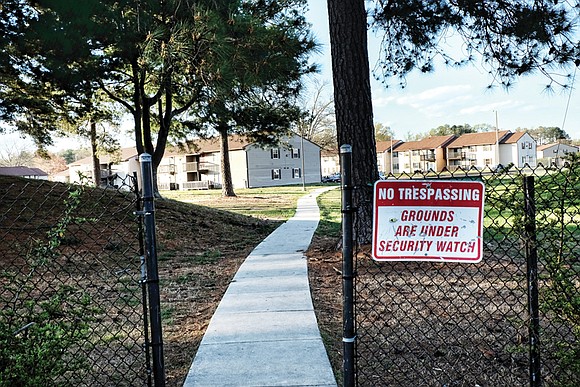Essex Village flunks HUD inspection
Jeremy M. Lazarus | 4/13/2017, 7:58 p.m.

After years of complaints, the U.S. Department of Housing and Urban Development is finally reacting to the deteriorating condition of Essex Village, the largest subsidized housing complex in Henrico County.
For the first time, HUD inspectors slammed the complex, finding that the property fails to meet minimum standards to justify the millions in government housing payments.
Already under pressure from Henrico County, the HUD action adds fresh urgency for the private group that owns the 496-unit apartment complex to invest in improvements.
Essex Village, located off Laburnum Avenue near Richmond International Raceway, is the county’s version of public housing.
Instead of a public housing authority, the complex is privately owned. It was designed to serve low-income people — and in this case, mostly African-Americans — who qualify for subsidies under the Section 8 or Housing Choice Voucher program.
The complex is a project-based program, meaning that people who rent there meet income limits. HUD pays subsidies for each apartment to the private group owners.
HUD’s latest action means that the owners are required to provide a plan and to undertake work within 60 days to bring the property into compliance with HUD’s physical condition standards and state and local building codes.
The failing grade has followed repeated complaints to the county of broken sewer lines spilling raw sewage onto the grounds, leaky windows, loose railings on porches and other problems.
The owners must certify that the problems have been corrected based on the HUD notice. Flunking a second inspection could force HUD to apply sanctions or begin the process of decertifying the property.
The HUD action is good news to Douglas Middleton, Henrico deputy county manager and former county police chief, who has labeled Essex Village “the worst of the worst” when it comes to housing conditions.
He believes HUD and Henrico officials now are on the same page when it comes to the condition of the complex.
He confirmed that in 2016 the county filed 140 violations against the largely faceless owners, Essex Village Investors LLC, and the national property management company, PK Management, the owners hired to operate the property on their behalf.
Mr. Middleton said the problems have been mounting since 2012, although he said the complex management generally responds and makes repairs after receiving a county notice of violation. That enables them to avoid having to go to court.
According to reports, tenants turned to the county after waiting weeks for reported problems to be addressed by the complex’s management.
County officials can only do so much because tenants, whose rent is sharply reduced because of the subsidies HUD pays to the complex, often keep quiet about problems out of fear of being evicted if they complain.
Henrico also has been frustrated after HUD inspectors repeatedly gave the complex passing grades, reducing the pressure to make improvements.
HUD’s decision to give the complex a failing grade followed Henrico’s efforts to finally meet with their counterparts in the HUD state office. The meeting was held last month.
According to county records, the owners and PK Management sought approval last year from HUD for a plan to spend $19 million to renovate the aging property and gain a larger yearly subsidy.
That proposal sank after Henrico officials, including Fairfield District Supervisor Frank Thornton, issued letters of opposition. Mr. Thornton feared the increases the complex was seeking would have priced out many current tenants.
Mr. Middleton said the county also plans to do more to improve conditions for residents, particularly the children.
He noted that 800 school-age children live in the complex.
“Somebody has to be interested in their welfare,” he said.







